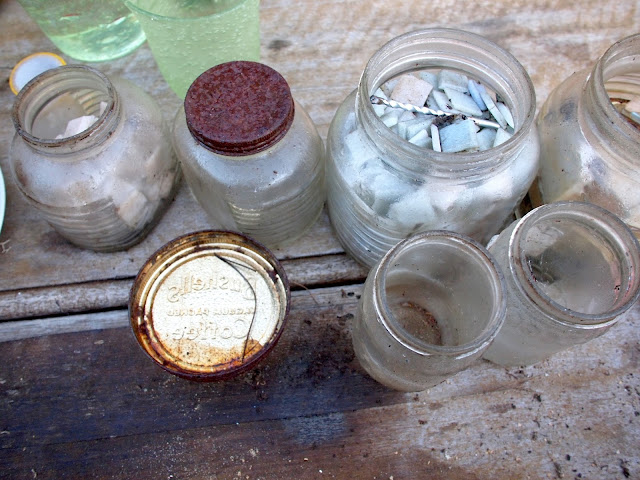I saw this on the web, via pinterest...
and realised it would be a good idea for us.
So with my gardener Renay this morning we made three bags today. We used produce bags, modest size. Even so with damp soil material inside they each way about 25kg (60lbs) at least. So not sure how we will place them in the end. Had had in mind stringing them along a cable, but it will be a heavy load for any cable system.
We are using produce bags which will decompose in sunlight. So after the soil and plants settle, and when they are in eventual place and not going to be moved again, we will put skirts of some fabric around them. We could use hessian but it's very expensive and we can find something bright at a charity shop.
I had learned from the discussion of other people's mistakes and adjustments at link.
The internet is wonderful when people write openly about their oopses.
So we did this:
[click on any picture to enlarge all)
 |
| from experience I knew holes should be small |

- put about 20cm of cocopeat, expanded in water, in bottom of bag. I put this moisture retaining medium at the bottom of the bag, with no supplements added, so that [a] the plant roots would in the first instance chase nutrients higher in the bag and [b] as nutrients wash down over time, this cocopeat layer will hold nutrients and not get toxically overloaded.
- placed a 50mm pvc pipe in the bag, with cap on bottom, one small hole in bottom three small holes up the pipe. An adaptor from 50mm to 100mm on top to make it easier to add water Tamped the bottom into the peat layer, to make stable.
- put had put the leg of an old pair of tracksuit pants around the pipe to slow water travel and prevent blockage of holes by roots. This task seemed to excite Renay.
- made a mix of the following:
- cocopeat with water added, also compost tea from our compost tea bin in garden which accepts weeds, manures, volcanic rock dust, etc,
- horse manure — which I am able to get from a source where it has been mulched
- cow manure — complexity requires
 |
| Easy to cut pvc pipe. | |
|
more stuff
- compost from our garden composter
- We filled the bag with this mix, tamping down lightly.
- We added some volcanic rock dust at intervals.
- Sewed up the top with baling twine, as comes with the bags of horse manure.
- Cut a total of six holes in each bag for strawberry plants.
- Planted the strawberry plants, all of which are runners from our strawberry patches.
The six small cuts for plants were made as follows:the cuts about 4cm + 4cm, slightly upwards to the centre, so when you pull the bag fabric it opens a little lip space and soil does not fall out.
- three cuts 120 degrees (evenly spaced) around towards the top at the shoulder level of the soil in the bag... the soil may settle, either the plant will grow out happily or we open the bag and add more soil.
- three cuts a bit further down, same 120 degree interval, offset.
These bags need to settle and the strawberries need to start growing in place now. July here is midwinter, no frost here, but close to freezing at the moment. I have places the bags in a row facing sun in a microclimate location with good sunlight. They are sitting on the ground with a half bag of manure front and back for stability. And a mirror behind to add warmth and light to the back of the bags. As the sun moves, the light shifts from bag to bag and also warms the manure bag.
 Three strawberry vertical garden bags in a row, mirror behind.
Three strawberry vertical garden bags in a row, mirror behind.
When the
soil is settled and roots developed and these are at their final
destination, we will find smart tight skirts for these bags, both for
aesthetics and also because the bags will disintegrate in sunlight over
time.
In any case, these are things for only one season or so, the soil
will, as with soil in pots, need refreshing.
Not hard to do. As runners
develop from these six plants I may make holes for them or begin new
bags, we shall see...
Now to find an old bench or such to rest them on, away from ground pests. Here we will also need defences from blackbirds and bowerbirds, for which a number of chopstick sized sticks coming out diagonally at the top with reflective scare tape dangling. Or maybe a net.



















